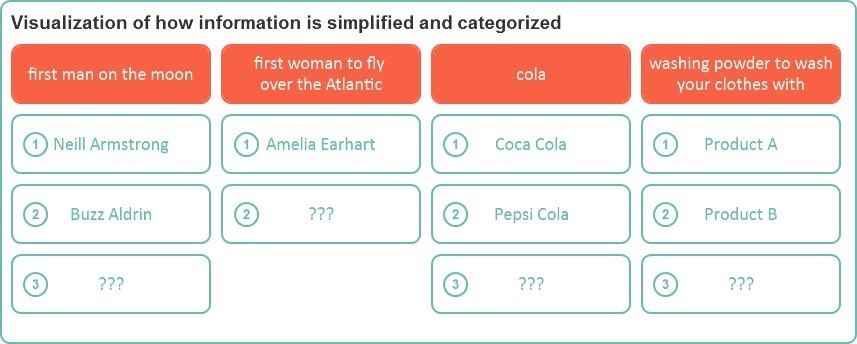Al Ries and Jack Trout wrote Positioning: The Battle for Your Mind more than 20 years ago, but the concepts hold true today when reaching target customers in a crowded marketplace.
Positioning is an aggregate of the perceptions that consumers hold in their minds concerning other products and companies. Once established, it’s difficult to change consumer perceptions.
Key Principles
Positioning: The Battle for Your Mind
- Once a consumer has formed an impression of your brand, it’s challenging to change their mind.
- Most market leaders were first in their category.
- Market leaders have a huge advantage and can leverage their status by co-opting competitor innovations
- If you can’t be first, create a new category.
- Reposition your competition
- Be wary of brand extensions
People Reject Incongruencies
In blind taste tests, people regularly choose Pepsi over Coke. Yet, Coke remains the top soft drink brand. The same tests, conducted when people can see the labels, results in more choosing Coke. Similarly, blind tests of various champagnes often rank the cheaper ones higher than expensive ones – until one knows about the prices.
If customers perceive your product as inferior, even a significant advertising investment is not likely to change that perception.
Embrace the Perception
Conventional wisdom often focused on shoring up weaknesses in product offerings. In the Positioning theory, you might have to accept the position already in a consumers’ mind. You either embrace that, reinforce it, or find a different point of attack.
Avis couldn’t beat Hertz head-to-head, so it embraced it’s #2 status. “When you’re only No. 2, you try harder. Or else.” They then extolled the advantages of going with number two: shorter lines, cleaner cars. “We’d be swallowed up if we didn’t try harder,” Avis advertised. Instead of trying to outgun their main competitor, they embraced their position and turned into a consumer benefit.

SOURCE: The Reference
Repositioning & The Product Ladder
As their research showed, most top products were first to market. If you can’t be first, you have to find a way to be first in another category. Avis was first at being #2!
Think of the mind as a series of ladders. Each ladder represents a category. The fuller the ladder, the more difficult it will be to move up the ladder and displace perceptions already formed in the customer’s mind.
Some ladders are full, such as fast-food restaurants. Burger King only ascended the ladder when it stopped trying to compete with McDonald’s as a quick-serve burger place and repositioned itself with “Have it Your Way.” Instead of trying to knock McDonald’s off the burger ladder, they created a new ladder: customized burgers.
Repositioning the Competition
Sometimes, there is no unique position to carve out. The Positioning strategy recommends repositioning your competitor. It’s not about telling them you’re better, but rather showing consumers the product in a new light.
Bayer was #1 in the pain reliever market until Tylenol started marketing the adverse side effects of aspirin. They let consumers know they could provide the same service – pain relief – without the potential side effects of regular aspirin use.
Be Wary of Brand Extensions
It’s tempting for established companies to leverage the power of their brand – especially when they’re at the top of the ladder. However, when your brand is established in the consumer’s mind, it’s tough to change it. Lifesavers, the candy with a hole in it, failed when it tried to launch Lifesavers Gum. It wasn’t until the relaunch as Bubble Yum, the first soft bubble gum, that it was successful. They create a new ladder.
It’s why companies like Proctor & Gamble, the world’s largest advertiser, continue to create new brands and new ladders for their products. It’s why they launched Downey fabric softener rather than Tide fabric softener. Tide, in the minds of consumers, was already laundry detergent. Rather than dilute the brand, they created a new category.
Brand extensions can work, Reis and Trout admit when there’s a crowded field of competitors. In most cases, however, they believe new brand names that can define a category stand a better chance of success.
Positioning for Leaders
In the short-term, market leaders are challenging to beat. Momentum carries them along as long as they maintain their product. Leaders should be working on creating a long-term strategy using the power of their position to stay ahead of the competition.
If they remain flexible, leaders can co-opt a competitor’s innovations.
Positioning for Followers
If you’re not in the leadership position, trying to copy the leader is almost always a recipe for failure. You need to create a new ladder or repositioning the competition.
“A product is something made in a factory. A brand is something made in mind. To be successful today, you have to build brands, not products.” – Ries & Trout
Positioning as a management and marketing concept is an essential and integral part of any marketing toolkit.

